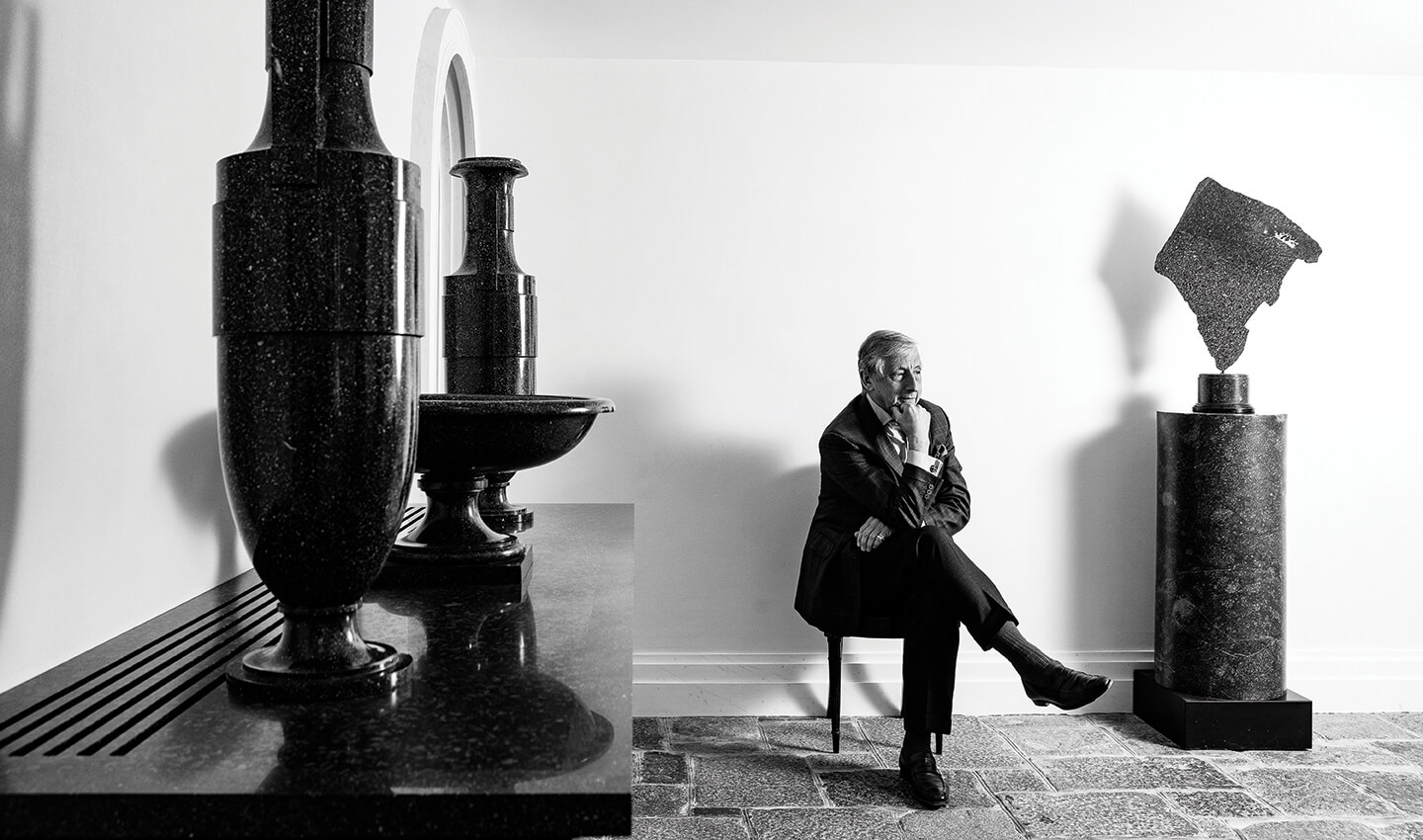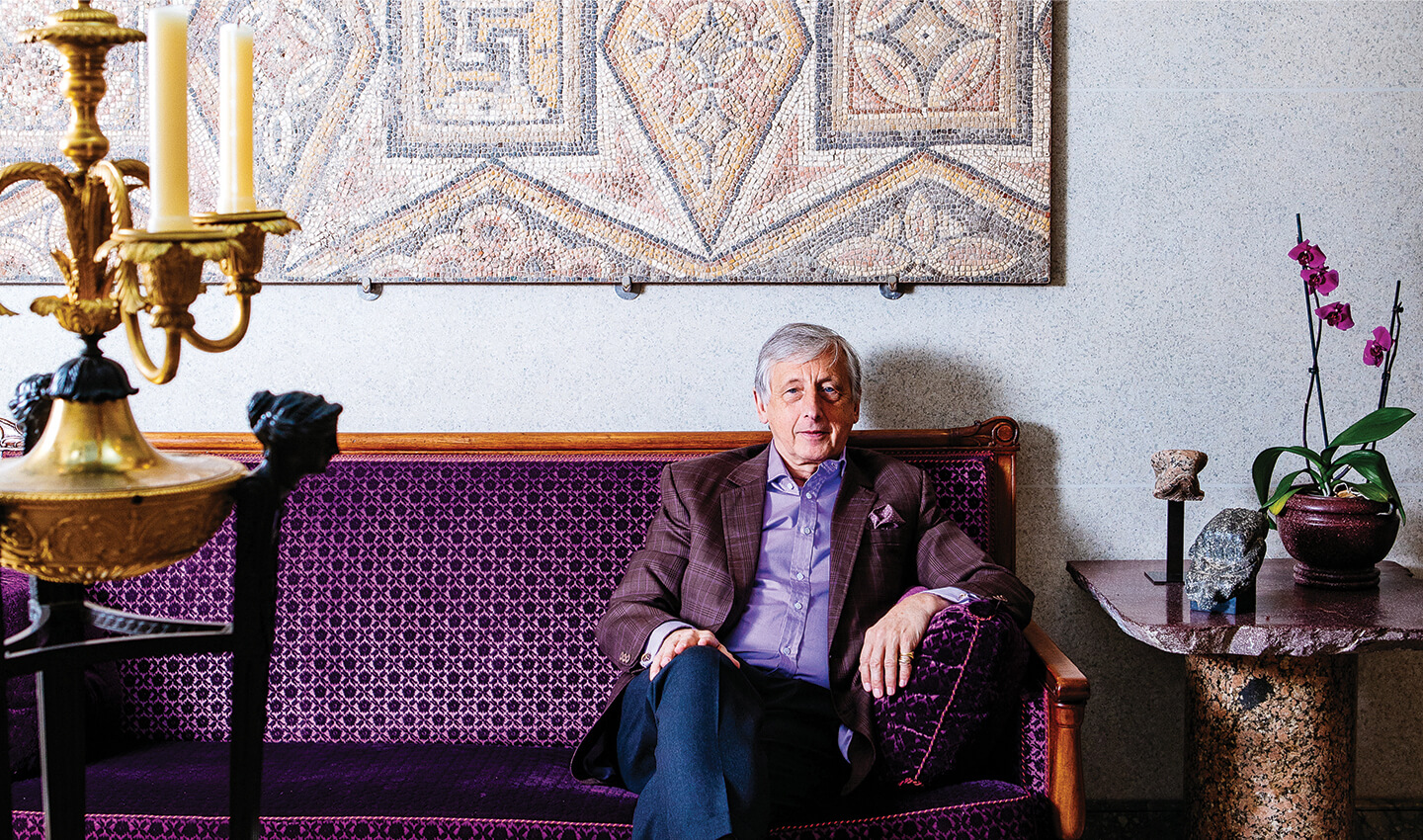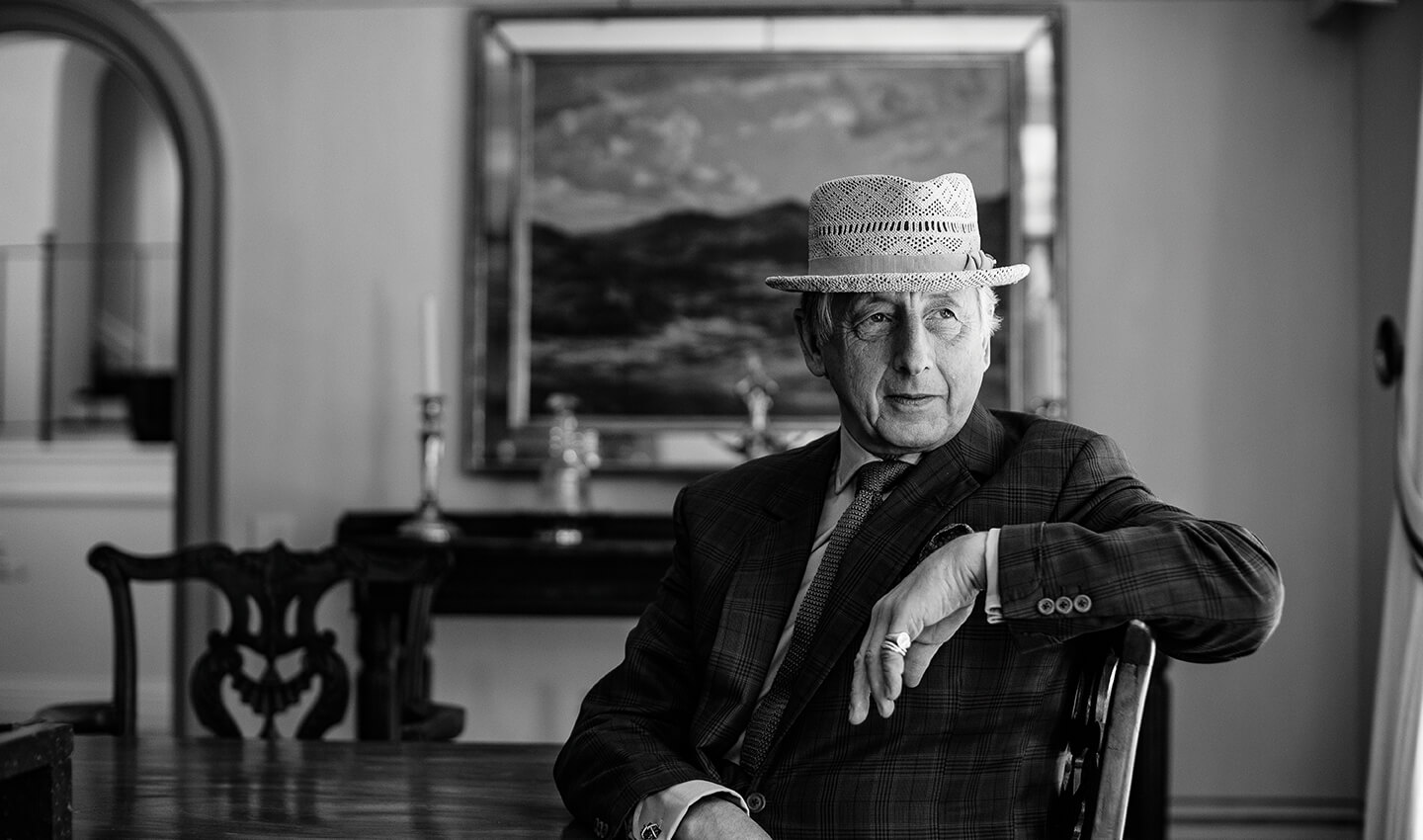I was surprised to hear that Philip Hewat-Jaboor did not originally plan a career in the art world. As a young man, having just finished formal education, he was going to travel to Switzerland and potentially enter the hotel trade. However, an invitation from the Chairman of Sotheby’s to attend a relatively new 12-month art course set him on the path that has now become a lifelong career and personal passion.
“There were five of us on the course and we were invited to go to London for a year to be really taught about the art world and to look at works of art and so on. I was incredibly lucky as it wasn’t something I was planning on doing, so it was a diversion really and it happened to fit well with my parents having just moved to Jersey. We had this extraordinary tutor who was completely remarkable and one of the great teachers of his time. We spent the year with him looking in depth at works of art, learning about them and being put through the aesthetic mill, so to speak.
At the end of the year, I was offered a job in a new part of Sotheby’s called Sotheby’s Belgravia, an auction house specialising in Victorian items which in those days were very unfashionable. We immersed ourselves in the 19th century and it was really pioneering because we were discovering what was good and bad and who made all these pieces and where they came from. We created a market by deciding what we felt was good, bad or indifferent. We were all enormously young. I was only 18 or 19, yet we had this huge responsibility and it went extremely well. Unfortunately, when Sotheby’s experienced a down-turn in business it decided, in its wisdom, to axe Sotheby’s Belgravia, which at that point was the only profitable part of the business.
After this, I went to work at Sotheby’s furniture department in Bond Street where I was part of a small group responsible for sourcing items for sales and subsequently set up what was to become the Client Advisory Department. This was before we had computers everywhere and we had to work manually through mountains of material on the available collections of the time. It was a very time-consuming and laborious job, but also incredibly valuable to me personally. I learnt a lot about art and also how people live with it. How people are attached to their art (or not) and what an important part works of art play in terms of not only living in a beautiful environment, but also in terms of financial tools. We had this astonishing resource of valuations and had to find out who still lived where, whether the owner was still married, getting divorced or even died; all the things that tend to precipitate sales.
I stayed there for 10 years and then Sotheby’s went public and at this point I felt that it was beginning to turn into a bit of a supermarket. For me personally, the thrill of the looking at the works of art was being diminished by the chase for profit. I’ve always been rather more interested in acquiring things on behalf of clients, which is why I then left to set up an art consultancy business which was a new type of business at that time.
There was a new wave of wealthy Americans coming to London in the early ‘80s, acquiring works of art and not necessarily getting it right. So, there was a need there for someone to be able to offer completely objective advice to people who were interested in buying and collecting art and then support them on how to get things shipped, conserved and insured etc.
Most of my advisor business has been with Americans which I enjoy hugely because there’s a general understanding in America that one should take advice in every area of your life which I think is very sensible.
I still act as a consultant but, with my work at Masterpiece, it has slipped slightly below the radar; but luckily not entirely.”

Masterpiece is the art fair that takes place each year in June and July within the grounds of the historic Royal Hospital Chelsea. Philip has acted as Chairman since 2012 and is justifiably proud of the reputation that Masterpiece has earnt as the world’s leading cross-collecting fair.
“One of my great joys with Masterpiece is that we have this fantastic opportunity to show the art world to a really wide range of individuals, from experts to people who have potentially never been exposed to it before. We work very hard to provide an environment where it is possible to discover all sorts of things that may never have been seen before. Masterpiece is full of works of art from leading dealers from all over the world and everything you see there has been examined and vetted by 28 committees made up of around 160-170 people. They look at every single object before Masterpiece opens to ensure that what’s on the label accurately reflects what it is.
We arrange the fair in a very multi-disciplinary way that is both unique and interesting. We have everything from classic material to contemporary art, sculpture, manuscripts, jewellery, furniture, paintings, watercolours, drawings, ceramics, glass and so on. We don’t put all the old master painting dealers in one corner and the modern furniture dealers in another. This delivers an extraordinary experience of coming to the fair and your eye is being caught by all sorts of things. It’s put together with great seriousness but in a very glamorous, comfortable way. It’s an incredibly alluring environment.
We work hard with our exhibitors to ensure that they display things carefully to give a feeling of how these pieces could work when you put them into a domestic setting. And it’s really all about taking down the barriers (or perceived barriers) of how to approach works of art. I think some people get frightened of going to galleries; there is a sort of resistance. So we try to make it a really welcoming, easy way of engaging.
Some of our dealers also share stands. For example last year, we had an antiquities dealer from New York who deals in Greek and Roman items who shared a stand with a dealer from Washington who brings great 20th century furniture. They put it together in a way that was so enticing, you could potentially say, ‘hmm I can do that at home too; this is not so overwhelming’. I think that taste for mixing things up is really coming back, not to just have contemporary or old pieces, but a well-thought out mix of everything.
One of the other areas I worked really hard on was to encourage our exhibitors to put prices on the labels because so many of the pieces are incredibly inexpensive and affordable. The hugely expensive items make the news, but at Masterpiece there is a real variety of different pieces that suit a spectrum of budgets from £1,000 to maybe £10,000,000.”
Philip is a self-confessed avid art collector, but he is not keen on the financial element that is so often associated with buying art.
“There are many different reasons why people buy works of art. I believe you should buy pieces, because you fall in love with them and they give you great pleasure. I don’t believe in buying for investment. There are probably better ways to invest one’s money and so that is an approach I would discourage. If you buy pieces that you absolutely love, they tend to be the best investments. But to actually go out looking for an investment which a lot of people do, particularly in the current contemporary market, is not really my thing.
I have seen collections put together where people have not had good advice. They’ve not taken enough interest, spent very large sums of money and ended up with a completely incoherent collection. To me, this is just a wasted opportunity.
Fashions come and go. People forget about that, particularly those who are buying for investment. I can give you endless examples of how the market flows. For example, in the early parts of 18th century, there was a certain type of blue and white Chinese porcelain that was incredibly valuable, and you were paying more for one of these vases than a Rembrandt. They are now almost worthless because it became obvious that there are rather a lot of them. They’re still very nice objects and the aesthetic value hasn’t changed, but they’re not fashionable anymore.”

Philip has spent nearly 45 years being immersed in the art world and his enthusiasm and knowledge is obvious and highly impressive, although he admits that even he is still learning. I asked him what advice he might have for someone who is keen to start collecting.
“I have a very simple recommendation and that is to handle your objects; this is absolutely vital. You cannot buy works of art without handling them, without seeing them in the flesh. You can buy things on the internet, but I believe you absolutely have to see the object so you can feel the weight and the texture. You can’t see the scale of something from a photograph.
You have to build relationships with dealers, art advisers and people you trust. It’s a question of honing your eye. You can read about these things but there’s absolutely nothing like engaging with the dealer and handling an object and learning from their experience what to look for and what not. You need to understand about allowable conservation, restoration and so on.
Art is not something that is daunting and terrifying; it absolutely shouldn’t be, but historically has been. I’m sure you all have stories about going into certain galleries where there’s somebody sitting behind the desk that doesn’t look up when you go in. Or there is something on the wall that doesn’t have a label and you have no idea what it is. We do the absolute reverse of this at Masterpiece. You can see the prices, meet the dealer or exhibitor and ask questions, learn the history or story about the piece and get a real feel for whether it is something that you love.”
As Chairman of ArtHouse Jersey, it’s Philip’s role to drive the organisation’s mission to support artists to make new work that has a positive impact in the local community and broader audiences around the globe. The new headquarters at Greve de Lecq are a suitably stunning setting for an organisation that concentrates on bringing beauty to the people of the Island.
“Our role is broadening and expanding, but the core element is to help support new work locally and produce opportunities to expose the Island to international artists through initiatives such as our residencies and ‘artist lock-ins’. This year, we are continuing the programme to take art into schools, which we did very successfully with the paper cutting exhibition in 2016. We are also putting a programme together to go into environments for people who are disabled or disadvantaged, giving them a chance to be exposed to art, whether it is music, paintings or anything. So we’re building a really exciting programme.
The knowledge about art can be acquired if you become interested, but there’s no reason why any sector of the world should be deprived of the opportunity to have access to it. You could argue that art is already accessible in that you can go to a museum, an exhibition, a church or a country house that is open and these things are generally free. However, at ArtHouse Jersey we continue to do what we can to help open this up to a wide audience from all backgrounds.
People shouldn’t feel excluded in any way, whether it’s here on the Island or coming to something like Masterpiece. All of these worlds that I’m involved in are accessible. You can get the pleasure from music; you can get the visceral pleasure out of being in a beautiful environment. And whether it’s looking at a sculpture, seeing a live band or going to the theatre, nobody should feel they can’t be engaged and get pleasure from the arts.
It’s really a question of opening people’s eyes to these things. It’s so easy to walk straight past something and not actually take a moment to look at it. Too often people are looking at the ground or texting, I think the environment in which any of us lives; whether it’s at home or out in public, plays such an enormously important role in everybody’s wellbeing.”
Arthouse Jersey not only works on opening up the arts to the people of Jersey but uses art to promote the Island internationally.
“We’re trying to add another string to the Island’s bow. I think it’s a key part of any civilised society to demonstrate that it is culturally engaged. We bring artists to Jersey, which can be very exciting, because those people then go back and say what a wonderful place Jersey is. It’s a much more expressive way of getting people involved in the Island, through the cultural aspects and physical beauty of Jersey.”

Philip’s stunning house in St Lawrence was inherited from his parents and for a long time he used it as a weekend house, spending the majority of his time living in London, or the home he shares with his partner in New York. Eventually, he decided to settle more permanently in Jersey and started the process of renovating the pair of 17th century cottages into a place that he could really call home.
“I wanted to remodel the house in a way that is more suitable for the things that I collect and the way I like to live.
I have objects that demand space, with light and air around them to really appreciate them and so I sat down with my designer and we worked together on putting all of this together.
I did the library first because I own an awful lot of books. So we came up with this idea of a semi-sunk, hidden gallery library space which houses most of the objects that wouldn’t fit in the main house. I am really lucky to be able to have a working library, but also a contemplative space. It’s quite a selfish space, but for me it works incredibly well.
It is most definitely home, and I’ve been trying to come a lot this year. I spend a great deal of time in New York because my partner is there and we’re now taking Masterpiece to Asia in October, so that is going to require rather more travelling.
However, I love the tranquility of Jersey. I have very good friends here and I think the Island is enormously beautiful and incredibly varied.
Whether someone wants to walk or cycle or sit on the beach, there is something for everyone. Jersey has two of the best castles in Europe and the fascinating story of the German occupation history is a big draw. We should relish the fact that we have all this fantastic history at our disposal.”
Philip spends as much time as possible in Jersey, but he is a busy man who still travels extensively. His enthusiasm for his work, however, is obvious. In the small amount of time I spent with him I was able to get a brief glimpse of the knowledge he has acquired and the enjoyment he takes in sharing this. Jersey is already a very beautiful place to live, but Philip is doing what he can to make it even more so. We finished our conversation with a reflection on the pleasure Philip gets from his work.
“The joy with what I’m doing is that I’m not consigned to one particular box. It’s all linked with my personal passion and everything else. So I’m very fortunate to be engaged in a life which is my passion. Some things I get involved with are paid work and some things are not paid work and that is all good and fine, but everything links. If I’m doing something for Masterpiece, it’s almost inevitably something that can help ArtHouse Jersey.
I think sometimes people need help in having their eyes opened for possibilities, and through my various endeavors, I do try my best to help with that.”


